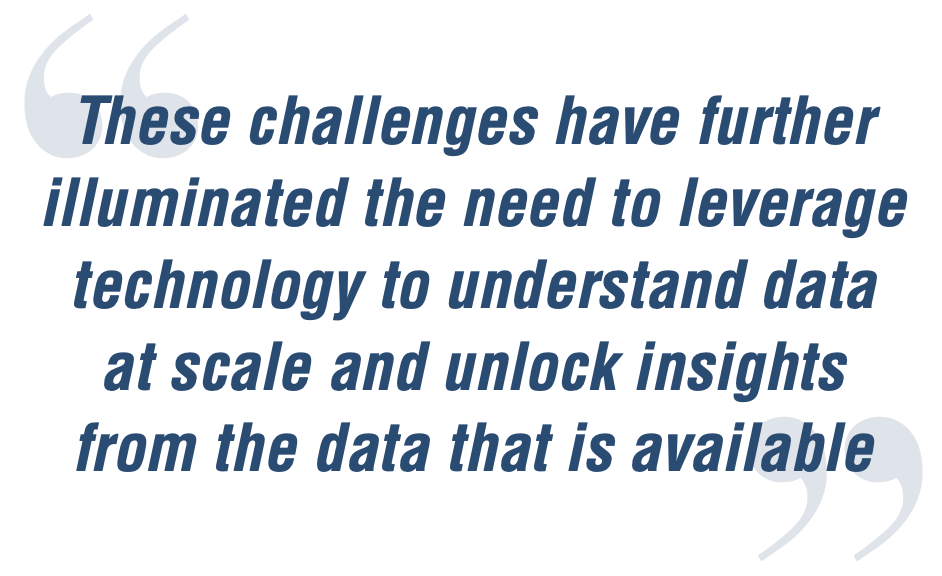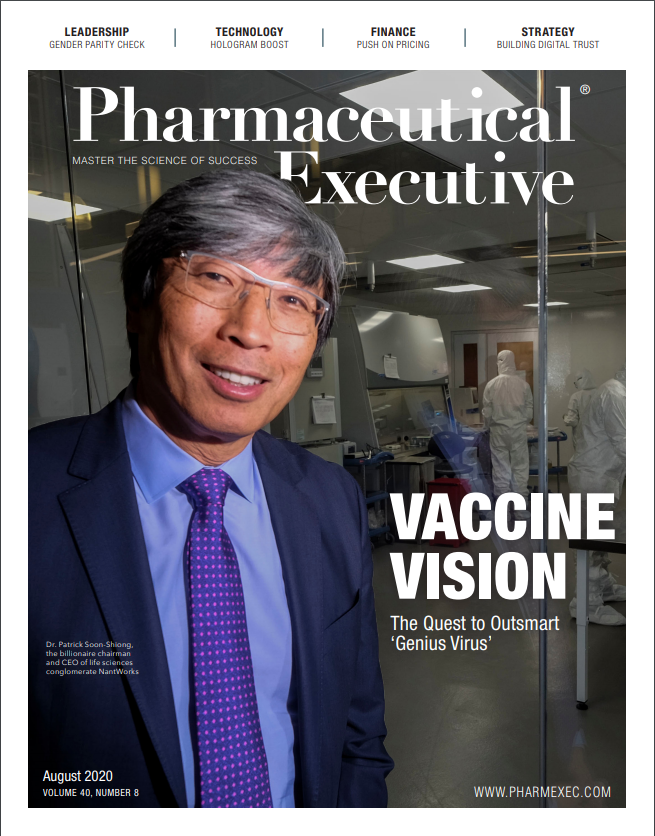The New Data Dynamic: How COVID-19 has Upended Model
While exposing gaps in the way pharma acquires and uses data, the pandemic has also fostered a new spirit of information sharing that bodes well for future collaborations.
Back in February, when COVID-19 was forming an ominous cloud on the horizon but had yet to fully disrupt the west’s daily healthcare discourse, ZS Principal Malcolm Sturgis reviewed the trends and predictions he had covered in his “State of the Data Nation” session at ZS’s recent Impact Summit. The message was that while the patient experience was becoming an ever-higher priority, data privacy and ownership concerns were constantly threatening to upend the status quo. He noted that pharma companies were still trailing behind other companies in finding meaningful ways to use data from non-traditional sources—connected medical devices as part of the Internet of Things, phones, Fitbits, and non-device data such as social media feeds. Part of the problem, he said, was “the creepiness factor” for patients. “If you’re a patient and you hear that all this [data] is being collected and centralized and it’s all about you specifically, it makes you feel a little nervous,” says Sturgis. “This is especially true if you hear that it’s not just your doctor collecting [it], but a pharma company or an insurance company or a big tech company like Google or Amazon.”
He continued that the industry would need to learn how to expose the data it has so that patients “can know what’s there and can have some control over what’s shared and what isn’t shared.” He added, “There are a lot of enterprise-level mechanics that have to be built to do this, as well as some standards and procedures and regulatory guidelines that may force the issue.”
Chief data and chief analytics officers, said Sturgis, would need to ask fundamental questions about understanding what data they have within their own companies and how they can work with patients to develop use cases for that data. “Some of the biggest opportunities may reside in gaps in the patient experience, and these may be opportunities that aren’t on our radar now but will be new capabilities that companies find they can’t leverage.”
Exposing the data gaps
Since February, however, COVID-19 has put some of these concerns on the back burner. Speaking to Pharm Exec last month, Sturgis observed that, when hospitals began performing only essential procedures and many practices were closing their doors, moves to give patients more visibility or control over their own data were effectively “put on hold.” For biopharma executives, the impetus changed to focusing internally on their immediate business situation. “That’s clearly critical,” notes Sturgis, “but it means they’re spending a lot of time tracking and understanding where sales are going, what’s going to happen next week, and which doctors have opened their doors.”
Malcolm Sturgis

This scenario has actually strengthened the argument for accessing data from non-traditional sources somewhat. Where, traditionally, many biopharma companies have acquired the data they need, built it into their IT infrastructures, and created big, central databases that they work with in-house, there is an increasing concern that “relying on your own in-house data isn’t going to tell you everything you need to know about your customers or your market,” says Sturgis. The difference now is that pharma has seen the need to access data that “isn’t perfect” and that doesn’t necessarily have to be “vetted and triangulated a hundred different ways.” Sturgis explains that the pandemic has meant that “knowing what’s going to happen next week, or even this week, and having that information available ‘right now’ has suddenly become more important.”
He notes that COVID also exposed a gap in companies’ understanding of local-level activity within each healthcare system. “Again, in the past, companies had the luxury of not really having to look at this; they had access to granular sales information, prescription dispense activity, or promotional activity that might tell them about what individuals are doing,” says Sturgis. “But now companies need to know where telehealth is being used, which hospitals are allowing non-elective surgery, which doctors are even seeing patients, etc.” The pandemic has changed all of the underlying assumptions about the market. In doing so, Sturgis explains, “it has exposed the need to understand transactionally what’s going on with all of your customers, how they are behaving, where things are going in the short term. There wasn’t a lot of attention paid to that before.”
For Joe Corkery, director of product at Google Cloud Healthcare & Life Sciences, COVID-19 has made data acquisition much more challenging. For example, collecting data for clinical trials often requires in-person examinations, physical sample collection, access to labs, and a variety of different mechanisms to capture patient-generated data along with patient-reported outcomes. But “as a result of COVID-19,” Corkery told Pharm Exec, “direct human interactions have been increasingly limited to the most urgent needs, which as expected has a real impact on the ability to run clinical trials.” This adds, he says, to COVID’s exposure of the “general lack of awareness around how challenging the drug/vaccine discovery process is,” as well as the importance of well-designed clinical trials to inform clinical decision-making. “The industry is having to get creative in the drug and vaccine discovery process, just like they are in many other ways,” says Corkery. “Many of these challenges have further illuminated the need to leverage technology to understand data at scale and unlock insights from the data that is available.”
Joe Corkery

Sharing the knowledge
Sturgis observes that pharmas are now looking at those non-traditional data sources and capturing data streams that were “never meant for pharma.” Putting this data together will mean fostering new partnerships with other stakeholders, such as large hospital systems or patient advocacy groups. Interestingly, this could be helped along by a kind of cultural shift with regard to data privacy that has been occurring among patients and organizations during the COVID pandemic.
“There is the notion with a public health issue like this—if everyone is affected by it and a patient’s data can be part of helping to understand and control it—that sharing data is a good thing,” says Sturgis. “This is a change from the skeptical narrative of the past few years.” And with regard to testing and contact tracing, he adds, “people are understanding that it’s not just about how they are affected personally, but whether the people around them will be affected too. There’s more awareness that our private health information may have value outside the individual.”

This growing spirit of altruism, or at least a strengthened willingness to work together, is a positive side-effect of the pandemic that has also become evident in industry practices. Corkery points out that the crisis has “opened doors” and is driving new alliances. As an example, he points the chemical simulation software company Schrödinger’s partnership with major biopharma companies such as Takeda, Novartis, and Gilead Sciences to discover novel antiviral therapeutics for COVID. “It’s really notable for these companies to be collaborating this closely,” Corkery says. Google Cloud is also involved in this alliance and is supporting its accelerated goals, such as the evaluation of billions of molecules each week, by donating cloud credits for high-powered parallel computing. Meanwhile, Google subsidiary Kaggle, an online community of data scientists with nearly five million users, is currently hosting data science challenges to help scientists accelerate their response to the pandemic. By May, there were roughly 357 scientific papers on COVID-19 being published every day. Kaggle is helping scientists navigate this wealth of research with a machine-learning-curated literature review, which is highlighting the key questions being explored.
Back in April, IBM Research announced it was making multiple resources available free to researchers, including a cloud-based AI research resource and the IBM Functional Genomics Platform. The firm has also played a leading role in launching the US COVID-19 High Performance Computing Consortium, which has made available to scientists more than 38 US-based supercomputers with “more than 400 petaflops of computing power.” And in March, six life sciences and information technology companies—including Caprion Biosciences, Clinerion, and Saama Technologies—announced the formation of the EndPandemic National Data Consortium, which is aimed at integrating data from all ongoing and future clinical studies to “dramatically accelerate analysis on COVID-19 and SARS-CoV-2 research.”
As Sturgis points out, collaborations are, of course, “not something totally foreign to the industry.” And from a commercial perspective, companies will continue to approach them with a degree of caution, wondering if they are giving up their “secret sauce” by joining such partnerships, or asking, “Is there more risk to this than benefit?” But, he adds, the idea that shared data can provide both corporate and public health benefits is a powerful one. And with companies being able to use and benefit from this information themselves, “there may very well be a recalculation about data sharing going forward.”
This willingness, then—on the part of both patients and pharma companies—to collaborate for the “common good” may have laid the groundwork for the future data dynamic. Corkery concludes: “We’ll come away from this pandemic with many lessons learned, some of which were learned the hard way. But I have hope that the next time the industry needs to come together, we’ll be ready and well equipped to do so in an open fashion.”
Julian Upton is Pharm Exec’s European and Online Editor. He can be reached at jupton@mjhlifesciences.com.

Regeneron, Roche Launch Major US Expansion Plans to Meet Growing Demand for Biologics and Innovation
April 22nd 2025With combined investments exceeding $53 billion, both companies are deepening their US presence through expanded biologics production, gene therapy capabilities, and next generation R&D centers.
Cell and Gene Therapy Check-in 2024
January 18th 2024Fran Gregory, VP of Emerging Therapies, Cardinal Health discusses her career, how both CAR-T therapies and personalization have been gaining momentum and what kind of progress we expect to see from them, some of the biggest hurdles facing their section of the industry, the importance of patient advocacy and so much more.